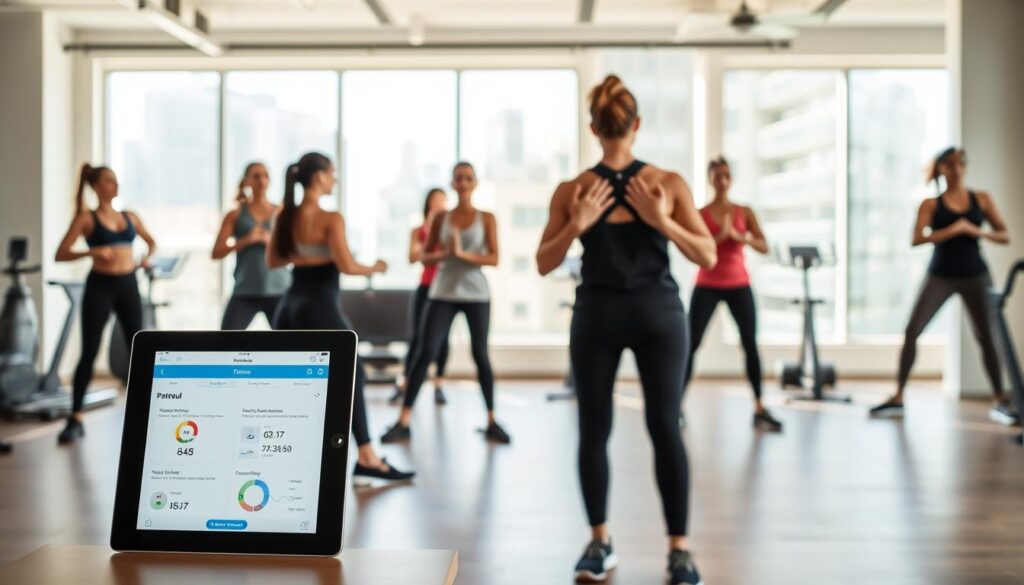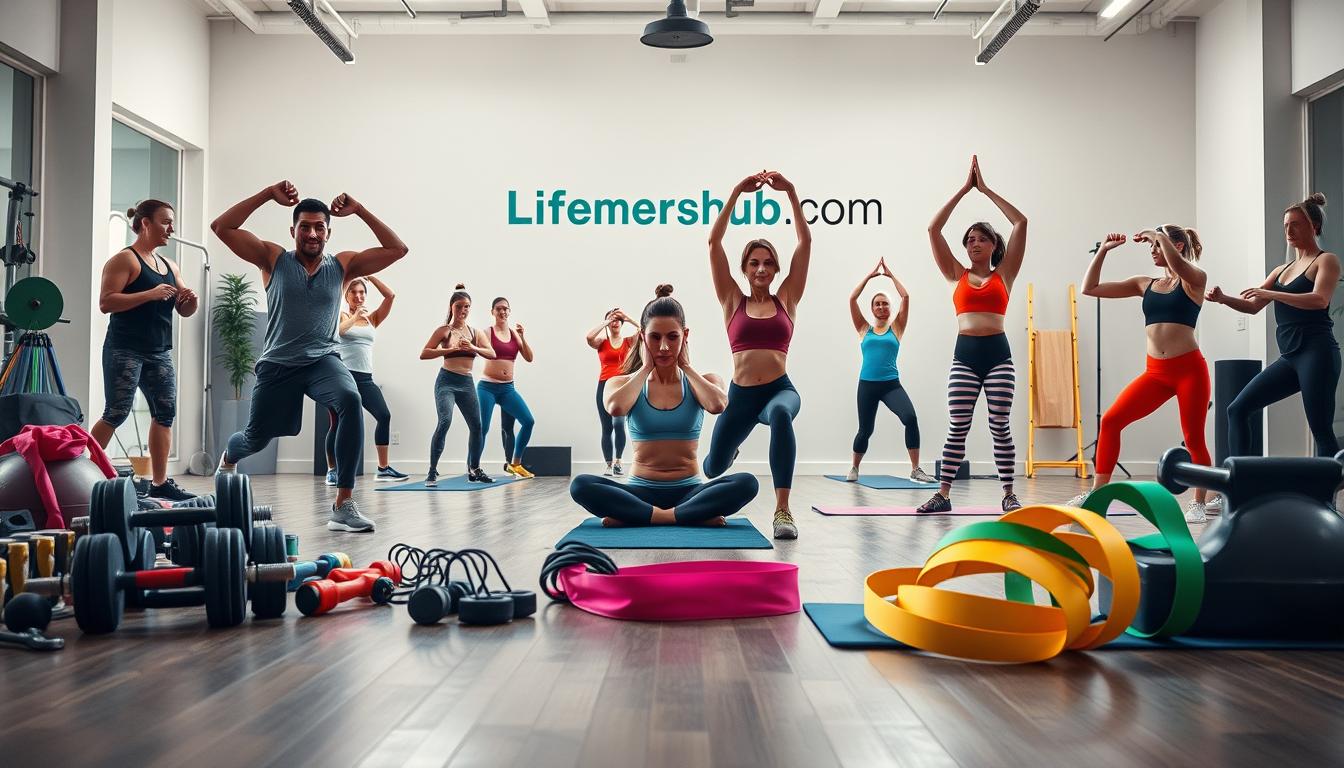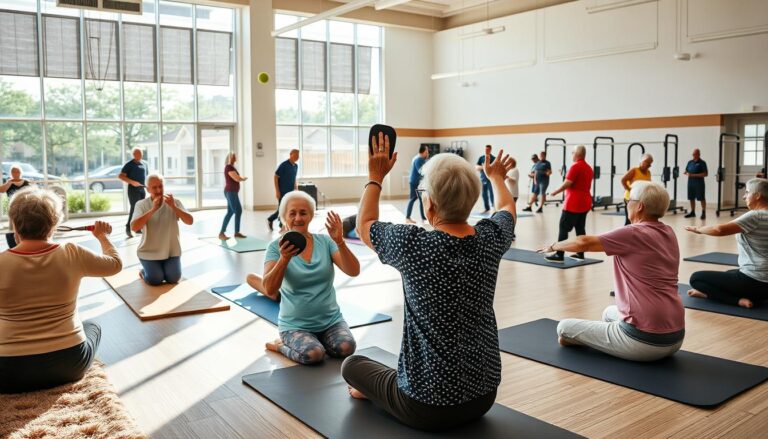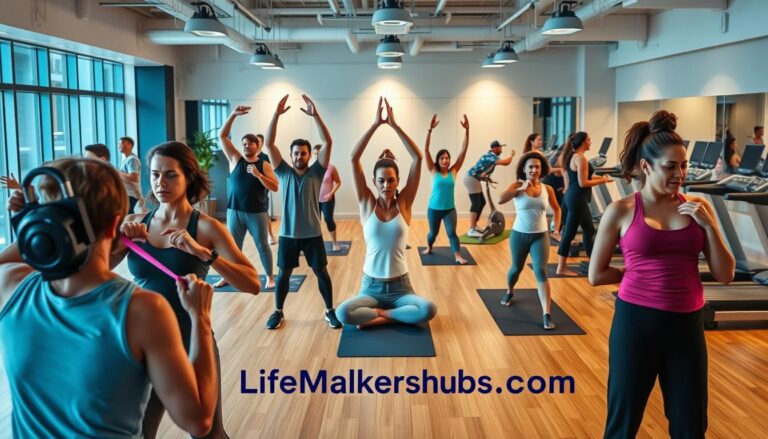Top Exercise Programs to Achieve Your Fitness Goals
Choosing the right exercise programs or fitness routines is key to reaching your goals. Whether you want to lose weight, build muscle, or boost endurance, it matters. Certified trainers say starting with clear goals is important.
They suggest structured workout plans to guide you. This is better than doing random exercises. It helps you make progress with routines made just for you.
Beginners might start with 3-day full-body workouts. More advanced programs might need 6 days a week. Apps like Nike Training Club (free) or Future ($199/month) offer personalized coaching.
Future gets a 5/5 rating for keeping users accountable. Nutrition plans that match calorie and protein needs also help improve results.
Key Takeaways
- Structured programs like Starting Strength (3x/week) deliver results in 6–9 months.
- Apps like Peloton ($12.99/month) and Caliber (free tier) balance cost and accessibility.
- Accountability matters: Future and Caliber score 5/5 for user feedback.
- Beginners should rest 90–180 seconds between main lifts to prevent injury.
- Programs like Critical Bench boost performance, with users gaining 50+ pounds on bench presses.
Understanding the Benefits of Structured Exercise Programs
Structured exercise regimens and physical training programs offer clear benefits over casual workouts. They lower the risk of chronic diseases and improve mental and social health. For instance, the CDC says 150 minutes of moderate activity each week can reduce heart disease and stroke risks.
Mental Health Improvements
Exercise fights stress and anxiety by releasing endorphins. Regular activity also improves sleep and brain function. Studies show it can cut depressive symptoms by up to 47% in adults.
People often feel more focused and emotionally strong with regular physical activity.
Physical Health Advantages
“Aerobic and strength training programs cut heart disease risks by improving circulation and cholesterol levels,” notes the American Heart Association.
Physical training programs that include aerobic, strength, and flexibility exercises lower diabetes risk by 35%. Adults who follow these guidelines are 50% less likely to die from flu complications than those who don’t exercise. Balance exercises also help seniors avoid falls by improving coordination and muscle strength.
Building a Sense of Community
Structured programs help build social bonds, making it easier to stick to routines. Group workouts increase accountability, with studies showing people in organized classes are 3x more likely to keep up with their routines. Shared goals and support in groups like yoga or cycling clubs keep motivation and enjoyment high.
Popular Types of Exercise Programs

Choosing the right exercise programs starts with understanding your options. Below are three foundational types proven to boost fitness and health:
Strength Training
Build muscle mass and bone density with routines using free weights, machines, or bodyweight exercises. Aim for personalized exercise programs that target all major muscle groups 2-3 times weekly. For example:
- 5×5 programs focus on heavy lifts for core lifts like squats and deadlifts
- Bodyweight circuits use push-ups, pull-ups, and dips
Cardio Workouts
| Type | Duration | Benefits |
|---|---|---|
| Steady-state | 30-60 minutes | Improved endurance |
| HIIT | 15-25 minutes | Time-efficient calorie burn |
| Cycling | Varies | Low-impact joint stress |
Adults need at least 150 minutes weekly of moderate cardio like brisk walking or cycling.
Flexibility and Balance
Incorporate yoga or tai chi for full-body mobility. Balance exercises like single-leg stands reduce fall risks, especially important for older adults. Pair these with dynamic stretches after workouts to improve range of motion.
“Stretching when muscles are warm reduces injury risk by 35% during workouts.” – American College of Sports Medicine
Remember: Combine these elements into a balanced routine. Always consult fitness professionals when starting new exercise programs to ensure safety and effectiveness.
How to Choose the Right Exercise Program for You
Choosing the right exercise program starts with understanding your unique needs. Custom workout routines or personalized exercise programs work best when tailored to your goals, lifestyle, and physical readiness. Follow these steps to find a plan that fits you:
Assessing Your Fitness Goals
Ask yourself:
- Am I aiming to lose weight, build strength, or boost endurance?
- Do I prefer group classes, solo sessions, or virtual coaching?
- How much time can I dedicate weekly?
Evaluating Your Current Fitness Level
Start with baseline assessments to avoid injury and set realistic milestones:
| Assessment Type | How to Measure | Why It Matters |
|---|---|---|
| Aerobic Capacity | Time to walk 1 mile or run 1.5 miles | Guides intensity and duration adjustments |
| Muscle Strength | Bodyweight exercises (e.g., push-ups, squats) | Shows starting resistance levels |
| Flexibility | Sit-and-reach test or yoga stretches | Prevents injury during workouts |
Considering Your Schedule and Lifestyle
Align your plan with your daily routine using these tips:
- Choose personalized exercise programs that fit your work hours and family commitments.
- Opt for shorter sessions if time is limited—multiple 10-minute bursts count toward weekly CDC guidelines (150 minutes moderate activity).
- Pick activities you enjoy to stay motivated long-term.
Remember: Consistency matters more than intensity. Start with one set of exercises per muscle group weekly, and increase duration by no more than 10% weekly to avoid burnout. Partner with a trainer or use apps like MyFitnessPal to track progress. Your ideal program balances science and personal preference—so you’ll stick with it!
Key Components of an Effective Exercise Program
Good workout plans or exercise regimens need certain parts to be safe, to progress, and to stick with it long-term. Without these basics, even the best plans can fail. Let’s look at what makes a plan work.
Warm-Up and Cool Down
Begin with a 5–10 minute dynamic warm-up. Use movements like arm circles or leg swings to get your heart rate up and loosen your muscles. After working out, spend 5–10 minutes on static stretches to boost flexibility. Skipping these steps can lead to injuries and less progress.
Intensity and Duration
| Type | Weekly Time | Frequency |
|---|---|---|
| Cardio | 150–300 minutes moderate | Most days |
| Strength | 2–3 sessions | Target all major muscle groups |
| Flexibility | 2–3 days | Hold stretches 15–30 seconds |
Do 8–12 reps for each strength exercise. If you find it too easy, add more weight to keep challenging yourself. Use a heart rate monitor or feel your effort to check how hard you’re working.
Progress Tracking and Adjustments
- Log your workouts in a journal or app like MyFitnessPal or Fitbit.
- Check your workout plans every 2–4 weeks. Change the intensity, time, or exercises if you’re not getting better.
- Use exercise regimens with different levels of intensity. This helps avoid getting too tired.
Keep track of things like push-up reps, run times, or how flexible you are. Celebrate your small victories to stay excited about working out!
Group vs. Individual Exercise Programs

Choosing between group or solo physical training programs depends on your goals and preferences. Group sessions offer camaraderie, while solo routines allow customization. Let’s break down the pros of each and explore blended options.
Participants in group exercise programs experienced a 26% reduction in stress levels after twelve weeks.
Group Workouts Boost Motivation and Community
Joining group exercise programs like CrossFit or yoga classes can boost adherence. Nearly 40% of regular exercisers prefer group settings. Studies show group participants are 24.8% more likely to stick with their routines. Benefits include:
- Accountability through shared goals
- Structured guidance from instructors
- Improved mental and physical quality of life
Solo Training Offers Customization and Freedom
Solo physical training programs let you tailor workouts to your schedule. Medical students in a study worked out longer individually but lacked the social engagement of group settings. Solo advantages include:
- Full control over exercise type and timing
- Privacy and reduced performance anxiety
- 11% higher mental well-being compared to non-participants
Hybrid Models: The Best of Both Worlds
Platforms like Peloton or Nike Training Club merge group and solo elements. Hybrid options combine:
- Virtual classes for social interaction
- On-demand workouts for flexibility
- Coaching apps like MyFitnessPal for tracking
| Aspect | Group | Solo | Hybrid |
|---|---|---|---|
| Motivation | Peer support | Personal goals | Virtual communities |
| Flexibility | Scheduled classes | Anytime sessions | On-demand options |
| Cost | Membership fees | Free or low-cost | Subscription-based |
Whether you thrive in a team or prefer solitude, the right mix of exercise programs can align with your lifestyle. Track progress with hybrid tools and prioritize what fuels your consistency.
Online Exercise Programs: A New Trend
Online fitness programs have changed how we exercise. Now, you can work out from home with virtual training sessions. This makes it easy and convenient.
Benefits of Virtual Training
Virtual training means no need for gym memberships. For example, gym memberships in the U.S. cost $507 a year. But, platforms like Peloton offer full access for just $39/month. The benefits include:
- Workout variety: Access classes from yoga to HIIT
- Privacy: Exercise without in-person judgment
- 24/7 availability: Stream sessions anytime
Popular Online Platforms
| Platform | Cost | Focus | User Base |
|---|---|---|---|
| Peloton | $39/month | Cycling, cardio, strength | 6.6 million members (2021) |
| Supernatural | $179/year | VR workouts | Rapid growth post-2020 lockdowns |
Tips for Staying Motivated Online
Make a dedicated workout space to stay focused. Use features like Peloton’s live classes or Supernatural’s milestone tracking. Pair sessions with wearables to monitor progress. Pro tip: Join community challenges—64% of users stay committed through social interaction.
“Completing my 800th Peloton ride on my birthday kept me accountable,” says Jessica Davis, a long-term user.
Online fitness programs now offer hybrid options. They blend home workouts with occasional gym visits. With digital downloads making programs scalable, this trend promises to keep evolving.
Incorporating Exercise into Your Daily Routine
Small changes can make daily tasks into chances for movement. The Centers for Disease Control and Prevention suggests 150 minutes of moderate activity each week. Break this into 10-minute bits to fit your schedule. It’s consistency, not how hard you’re working, that leads to lasting success.
“Regular physical activity reduces the risk of chronic diseases like diabetes and heart disease,” states the CDC.
Making Time for Fitness
Plan your day to make room for fitness routines. Try these:
- Set up morning workouts like you would any other meeting.
- Use fitness trackers to remind you to move every hour.
- Link workout plans with daily tasks, like parking further from stores.
Fun Ways to Stay Active
Make exercise fun. Try these activities:
- Join dance classes or follow online tutorials.
- Walk your dog twice a day (studies show this can help you lose 11–15 pounds a year).
- Play outdoor games with your family.
Incorporating Movement into Work
Break up sitting with these office-friendly tips:
| Activity | Time | Example |
|---|---|---|
| Standing desk | 4+ hours/day | Replace 2 hours of sitting with walking meetings |
| Desk exercises | 5 minutes/hour | Stretching or calf raises |
Mixing movement with fun and practicality makes workout plans into habits, not challenges.
Nutrition and Exercise Program Synergy
Your exercise programs and eating habits are a strong team. Good nutrition helps your workouts, speeds up recovery, and boosts results. Without the right food, even the best custom workout routines won’t do much.
Science shows that 80% of people who combine nutrition coaching with fitness achieve lasting weight loss and stick to their plans.
“90% of gym-goers who worked with a nutritionist achieved their goals within six months, versus 60% who trained alone.” – International Health, Racquet & Sportsclub Association
Importance of Proper Nutrition
Lean proteins, complex carbs, and healthy fats are essential for your body. Research shows that those who get nutrition advice improve their body shape faster than those who just exercise. For instance, breast cancer patients in studies gained more muscle and lost fat when they combined aerobic training with diets full of omega-3s and antioxidants.
Meal Planning for Fitness Enthusiasts
Plan your meals to enhance your performance:
- Pre-workout: Eat 300-400 calories of carbs + protein 1-2 hours before sessions
- Post-workout: Consume 20-30g protein within 45 minutes to rebuild muscle
- Meal prep weekly using containers for portion control
Adjust your diet to meet your goals. Need to build muscle? Eat more protein. Want to lose weight? Focus on fiber-rich foods. The Mediterranean diet, rich in fish, nuts, and vegetables, is great for both brain and muscle health, as seen in the Framingham Heart Study.
Hydration Strategies
Even mild dehydration can cut performance by 10%. Aim for:
- 20-30 oz water 2-3 hours before exercise
- Sip 7-10 oz every 10-20 minutes during workouts
- Electrolyte drinks for sessions over 90 minutes
Check your urine color – pale yellow means you’re well-hydrated. Use these tips with your custom workout routines for the best results. Talk to a dietitian to make sure your nutrition matches your fitness goals.
Success Stories from Various Exercise Programs
Real people show that structured exercise programs really work. JoAnn’s story is a great example. She changed her life through consistent workouts and fitness routines.
Her journey with The Exercise Coach and the C25K plan shows lasting change is possible. It proves that with the right program, you can see real results.
Transformative Journeys
JoAnn lost 107 pounds in 18 months with The Exercise Coach. She started at 210 pounds and now runs at 7 mph. Her story shows how small, consistent efforts can lead to big changes.
She followed the C25K plan, which helped her reach her goals. Her experience backs up research on the effectiveness of structured exercise programs.
Overcoming Challenges
When JoAnn hit a plateau, she changed her diet. She started eating low-carb meals and tried intermittent fasting. This flexibility in her program helped her overcome obstacles.
She learned that adjusting nutrition or workout intensity can help. In the first six months, she lost 30 pounds. This shows that with the right approach, you can overcome challenges.
Testimonials from Participants
JoAnn says, “The Exercise Coach’s 20-minute workouts fit my schedule perfectly.” Many participants share similar feelings. They find confidence in tailored fitness routines.
Her journey, from walking to running, proves structured programs work. It shows that with dedication, you can achieve your fitness goals.
FAQ
What are the benefits of following a structured exercise program?
How do I choose the right exercise program for my goals?
What are the key components I should look for in an exercise program?
Are group workouts better than individual training sessions?
How can online exercise programs be beneficial?
What role does nutrition play in my exercise program?
How can I stay motivated while following an online fitness program?
What are some strategies to integrate exercise into a busy lifestyle?
Source Links
- Workout Routines for Men: The Ultimate Guide
- 11 Best Online Workout Programs of 2025 | Garage Gym Reviews
- Which Fitness Program Is Right for You?
- Benefits of Physical Activity
- 5 basics of a well-rounded fitness routine
- Systematic Review to Inform a World Health Organization (WHO) Clinical Practice Guideline: Benefits and Harms of Structured Exercise Programs for Chronic Primary Low Back Pain in Adults
- Three Types of Exercise Can Improve Your Health and Physical Ability
- American Heart Association Recommendations for Physical Activity in Adults and Kids
- 20 Different Types of Exercise to Try When Starting a Fitness Routine | Hydrow
- 5 steps to start a fitness program
- Choosing The Best Workout For You | BenchMark Physical Therapy
- Elements of an Effective Exercise Program
- What Are the 5 Health-Related Components of Physical Fitness?
- Group exercise may be even better for you than solo workouts – here’s why – Department of Kinesiology
- Researchers Find Group Exercise Improves Quality of Life and Reduces Stress Far More Than Individual Exercise
- Virtual workouts spiked during the pandemic — and the trend is sticking around
- The 9 Ultimate Online Fitness Trends for 2025
- How to Start Exercising and Stick to It – HelpGuide.org
- Seven Easy Ways to Include Exercise in Your Daily Routine
- Fitness Plus Nutrition | Five Diamond Fitness & Wellness Blog
- The synergistic effect of physical activity and nutrition to improve the quality of life in breast cancer patients: a systemic review
- Neuro-Nutrition and Exercise Synergy: Exploring the Bioengineering of Cognitive Enhancement and Mental Health Optimization
- A WHOLE NEW JOANN: PART 2 – THE EXERCISE COACH® DIFFERENCE | Exercise Coach
- I Lost 70 Pounds from Healthy Eating, Exercise, and Betting Money on My Success







